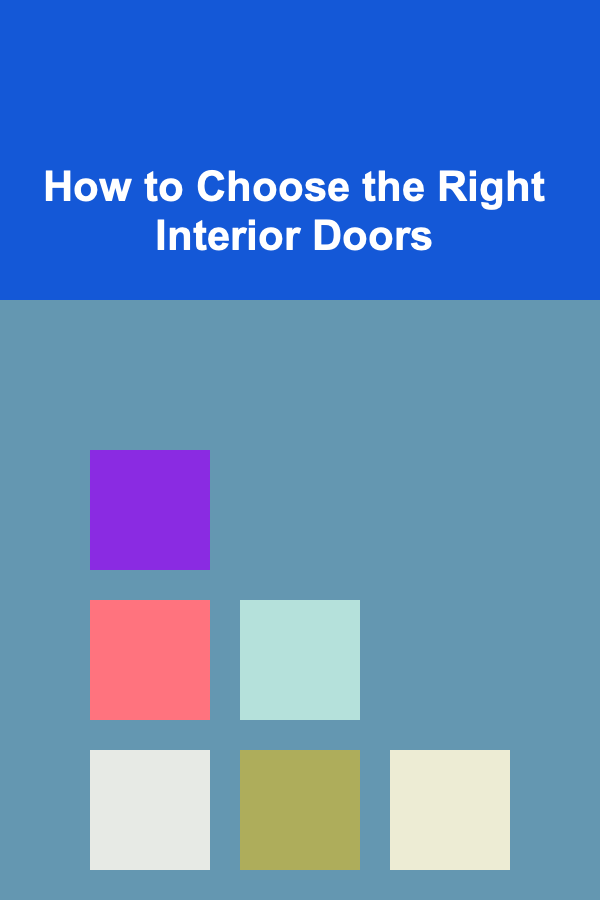
How to Choose the Right Interior Doors
ebook include PDF & Audio bundle (Micro Guide)
$12.99$9.99
Limited Time Offer! Order within the next:

When designing or remodeling a home, selecting the right interior doors is an important decision that goes beyond simple functionality. Interior doors can significantly influence the aesthetic of your space, contribute to privacy, and enhance the overall ambiance of your rooms. Whether you're building a new home or renovating an existing one, the choices you make regarding interior doors will play a crucial role in your living experience.
Choosing the right interior doors requires careful consideration of several factors including material, style, functionality, and budget. In this article, we'll explore the various aspects that should guide your decision-making process, helping you to select the perfect doors that complement your home's design and meet your practical needs.
Understanding the Purpose of Interior Doors
Before diving into the technicalities of design and materials, it's essential to recognize the primary functions of interior doors. Interior doors serve several key purposes in any living space:
- Privacy: Interior doors provide privacy in bedrooms, bathrooms, offices, and other spaces that require separation from the rest of the house.
- Sound Insulation: In homes with shared spaces, like apartments or multi-generational households, interior doors help reduce noise transmission between rooms.
- Aesthetic Appeal: Doors contribute significantly to the visual flow and design of a room. Whether you're going for a traditional, contemporary, or minimalist look, the right door can enhance your space's overall style.
- Space Management: Some doors are designed for efficient use of space, especially in smaller homes or apartments. For example, pocket doors or bi-fold doors can provide the same functionality as traditional doors while saving room.
With this in mind, think about the specific functions you need from your doors and how they will fit into your home's overall layout.
Types of Interior Doors
Interior doors come in a variety of types, each suited to different purposes and room configurations. The most common types include:
2.1. Hinged Doors
Hinged doors are the most traditional and widely used type of interior door. They swing open on a set of hinges attached to the door frame. Hinged doors are versatile and available in various styles, materials, and sizes. They are perfect for rooms where space isn't an issue, as they require clearance on both sides of the door to open fully.
Pros:
- Classic design that suits almost every room.
- Offers a wide range of material options such as wood, glass, and composite materials.
- Provides excellent privacy and security.
Cons:
- Requires space for the door to swing open.
- Can be difficult to install in smaller rooms or tight spaces.
2.2. Sliding Doors
Sliding doors are a modern alternative to traditional hinged doors, and they slide along a track to open and close. These doors are particularly popular for closets, bathrooms, and as room dividers in open-concept spaces.
Pros:
- Space-saving solution ideal for smaller rooms.
- Works well for wide openings and can be used as a way to divide large spaces without the need for a swing arc.
- Stylish and contemporary appearance.
Cons:
- May not provide as much soundproofing or privacy as hinged doors.
- Can be more challenging to maintain due to the sliding mechanism.
2.3. Bi-Fold Doors
Bi-fold doors are a series of panels connected by hinges, which fold in on themselves when opened. They are commonly used for closets, laundry rooms, and as room dividers.
Pros:
- Space-efficient and ideal for small spaces.
- Offers a wide opening when fully opened, making them a good choice for closets or pantries.
- Modern and sleek appearance.
Cons:
- Can require regular maintenance, particularly with the folding mechanism.
- May not be the best option for areas that need high privacy or sound insulation.
2.4. Pocket Doors
Pocket doors are sliding doors that disappear into the wall when fully opened, making them an excellent space-saving choice for tight areas like bathrooms, hallways, or small bedrooms.
Pros:
- Great for areas with limited space.
- Offers a clean, minimalist look without the need for extra clearance.
- Silent and smooth operation.
Cons:
- Installation can be complex and costly due to the need for wall modifications.
- Not always as secure or private as hinged doors.
2.5. French Doors
French doors are double doors that open outward, usually made with glass panels. They are perfect for rooms that lead out to patios, gardens, or other outdoor areas. They offer an elegant, sophisticated look while allowing natural light to flow between spaces.
Pros:
- Stylish and elegant, adding charm to your home's interior.
- Perfect for connecting rooms or blending indoor and outdoor living areas.
- Allows natural light into a room.
Cons:
- Can be more expensive due to the use of glass.
- May not provide as much privacy or soundproofing.
Choosing the Right Material for Interior Doors
The material you choose for your interior doors is one of the most significant factors in terms of both function and aesthetic appeal. Here are some common materials used in interior doors:
3.1. Solid Wood Doors
Solid wood doors are a popular choice due to their strength, durability, and timeless aesthetic. They offer excellent insulation and soundproofing properties, making them ideal for bedrooms and bathrooms. Solid wood doors also add value to a home and are available in various finishes and designs.
Pros:
- Strong, durable, and long-lasting.
- Excellent soundproofing properties.
- Adds aesthetic value to your home.
- Can be custom-made to fit your style.
Cons:
- Can be expensive.
- Prone to warping or swelling in humid conditions.
- Heavier than other materials, which may require stronger hinges.
3.2. Hollow Core Doors
Hollow core doors are made of a thin veneer or laminate with a cardboard core. These doors are lightweight and affordable, making them an attractive option for budget-conscious homeowners. While they may not offer the same durability or soundproofing qualities as solid wood, they are ideal for interior rooms that do not require high levels of privacy.
Pros:
- Affordable and lightweight.
- Easy to install.
- Available in a variety of designs and finishes.
Cons:
- Less durable than solid wood doors.
- Lower soundproofing and insulation capabilities.
- Prone to damage from impact or moisture.
3.3. MDF (Medium Density Fiberboard) Doors
MDF doors are made from compressed wood fibers and resins. They are known for their smooth, even surfaces and are commonly used for painting. MDF doors offer a good balance of affordability, strength, and versatility.
Pros:
- Smooth surface ideal for painting.
- More durable than hollow core doors.
- Resistant to warping and cracking.
Cons:
- Not as durable as solid wood.
- Heavier than hollow core doors.
- Less natural appearance compared to real wood.
3.4. Glass Doors
Glass doors, often used for French doors or as room dividers, offer a more open, airy feel to a room. They are ideal for spaces where you want to allow natural light to pass through, such as between living rooms and dining rooms or between the interior and a patio.
Pros:
- Allows natural light to flow through rooms.
- Adds a modern, elegant look to your home.
- Great for open-concept designs.
Cons:
- Offers less privacy.
- Can be expensive and more fragile than solid doors.
- Requires regular cleaning to maintain clarity and appearance.
Style and Design Considerations
When choosing interior doors, the style and design should complement your home's overall aesthetic. Whether you are designing a traditional, modern, rustic, or minimalist interior, the right door style will tie the room together and enhance its character. Here are some design factors to consider:
4.1. Door Panel Design
Interior doors come in various panel designs, from simple single-panel doors to more intricate designs with multiple panels. You can choose from raised, flat, or recessed panels, and the pattern you select should align with the style of the room.
4.2. Color and Finish
The color and finish of your doors should complement the room's color scheme. For instance, if you have light-colored walls, a darker door finish can add contrast and sophistication. Wood doors can be left in their natural finish or stained to match the room's décor, while MDF and hollow core doors are often painted to achieve a uniform look.
4.3. Door Hardware
Doorknobs, handles, and hinges are small details that can significantly impact the appearance of your door. Choose hardware that complements the style of your door and the overall design theme of the room. For a traditional look, opt for brass or polished nickel, while modern spaces may call for sleek, minimalist handles in matte black or chrome.
Budget and Maintenance
Your budget will also play a significant role in determining the type and material of interior doors you choose. While solid wood doors are undeniably beautiful and durable, they tend to be more expensive. On the other hand, hollow core or MDF doors offer budget-friendly options with decent performance.
Maintenance should also be considered when choosing your doors. Solid wood doors may require periodic refinishing to maintain their appearance, while MDF and hollow core doors are generally low-maintenance. If you're installing glass doors, be prepared for regular cleaning to maintain their clarity.
Conclusion
Choosing the right interior doors is a crucial part of home design that blends practicality with style. By considering the purpose, material, design, and functionality of your doors, you can make informed decisions that enhance both the look and the feel of your home. Whether you're drawn to the classic elegance of French doors or the modern appeal of sliding doors, the right choice will elevate your space and create an atmosphere that reflects your personal taste and lifestyle.

How to Choose the Right Pet Carrier for Travel Comfort
Read More
How to Deep Clean Your Kitchen in Just One Day
Read More
How to Present Market Research Results to Clients or Stakeholders
Read More
How to Protect Your Investments During Market Volatility
Read More
How to Refresh Your Home with Budget-Friendly Seasonal Decor
Read More
What to Do if You're Overqualified for the Job You Want
Read MoreOther Products

How to Choose the Right Pet Carrier for Travel Comfort
Read More
How to Deep Clean Your Kitchen in Just One Day
Read More
How to Present Market Research Results to Clients or Stakeholders
Read More
How to Protect Your Investments During Market Volatility
Read More
How to Refresh Your Home with Budget-Friendly Seasonal Decor
Read More